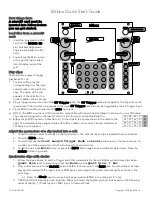
ARPEGGIATOR SECTION
The lower parameter is “Output ranging”. In this case with a value of Off.
This parameter applies when Arpeggiators are used in Performance Mode. When set to ‘On’, this parameter checks to see if the
Arpeggiator’s final note value (taking into account the current ‘octaves’ shift & any ‘real-time’ transposing) falls within the Part’s note
range parameters. If the final note value falls outside this range, it is not passed on to the Program or MIDI. When Output Ranging
is set to ‘Off’, the final note value will always be passed on to the Program or MIDI. Previous OS Versions always behaved as if
Output Ranging was set to ‘On’. Use the lower Data knob to adjust the value. The range of this parameter is On & Off. This para-
meter is memorised with a Program.
When Output Ranging is set to ‘on’, it is possible to obtain interesting Arp pattern variations by adjusting the Part’s range values in
such a way that certain Arpeggiated notes fall outside the Part’s range & are not sounded.
On/Off - Button
This buttons determines if the Arpeggiator is active or disabled in the currently selected program. Pressing this button makes the
Arpeggiator active & the button will light. Pressing it again will deactivate the Arpeggiator & the light will go out. The range of this
parameter is On & Off. This parameter is memorised with Programs in Program mode & Performances in Performance mode.
Latch - Button
This button determines the way in which the Arpeggiator remembers which notes you are playing or have played on the master
keyboard. When this is “Off” ( unlit ) the Arpeggiator will only sweep through its patterns when you hold down notes on the master
keyboard. If you are not playing any notes on the master keyboard no arpeggio will be heard. If the “latch” is set to “On” ( Lit ) the
Arpeggiator remembers what notes you last played. i.e. If you play a C triad & then release the keys on the master keyboard the
Arpeggiator will not stop, it will continue to sweep through the C triad until a new set of notes is played, then it will sweep through
the new notes until another set it played. etc. etc. The range of this parameter is On & Off. This parameter is memorised with a
Program.
This parameter can be controlled via the Sustain pedal in the Performance mode. To do so connect a Sustain Pedal to the Input/sw
2 (Sustain) socket & assign the socket to act as a suitable polarity Footswitch socket on page 9 of the global mode. The
Supernova II Rack can read Sustain information as Arpeggiator latch On / Off, so depressing the Sustain Pedal connected to the
Input/sw 2 socket will switch the Arpeggiator Latch “On” & releasing the Sustain Pedal will switch it “Off”. For this to work properly
set the “Sustain” parameter in the MIDI button menu for the selected Part to “Arp Latch”. Additionally, this parameter may work in
reverse to the manner described if the incorrect footswitch is used with the master keyboard. If this is the case, change the polarity
of the Footswitch socket on page 9 of the global mode. In Program Mode, the Sustain Pedal always latches the Arpeggiator while it
is enabled. If the Arpeggiator is not enabled, the Sustain Pedal will act as a normal Sustain.
Mute - Button
This button determines if the Arpeggiator is heard in the currently selected Program. When this button is unlit the Arpeggiator is on
& the sound can be heard. In the “Muted” ( Lit ) position, the Arpeggiator is still running in the background but is no longer passing
the notes to the Program or MIDI & the sound can no longer be heard. This parameter is memorised with a Program.
This feature will mute/unmute an external synthesiser being controlled by the arpeggiator via MIDI. ( If the Arpeggio notes to: para-
meter on page 6 of the Arp menu is set to MIDI only or Program & MIDI )
Keysync - Button
This parameter controls the way the Arpeggiator resets itself when new notes are played on the master keyboard. In the “Off” posi-
tion ( unlit ) the cycle of the Arpeggiator is not interrupted when new notes are played on the master keyboard, the Arpeggiator sim-
ply changes the notes being played to the new ones. In the “On” position ( lit ) the cycle of the Arpeggiator is reset to the start of its
patterns when new notes are played on the master keyboard. In this condition if the Quantise parameter on page 2 of the Arp
menu is set to “Off” it behaves like triggering a loop in a sequencer. If the Quantise parameter is set to modes 1 or 3, the reset will
occur at the start of the next step. If the Quantise is set to modes 2 or 4, notes played slightly late will reset immediately & follow-
ing steps will be in sync. The range of this parameter is On & Off. This parameter is memorised with a Program.
NOTE:
NOTE:
NOTE:
NOTE:
58
Содержание Supernova II
Страница 145: ...145 NOTES...
















































